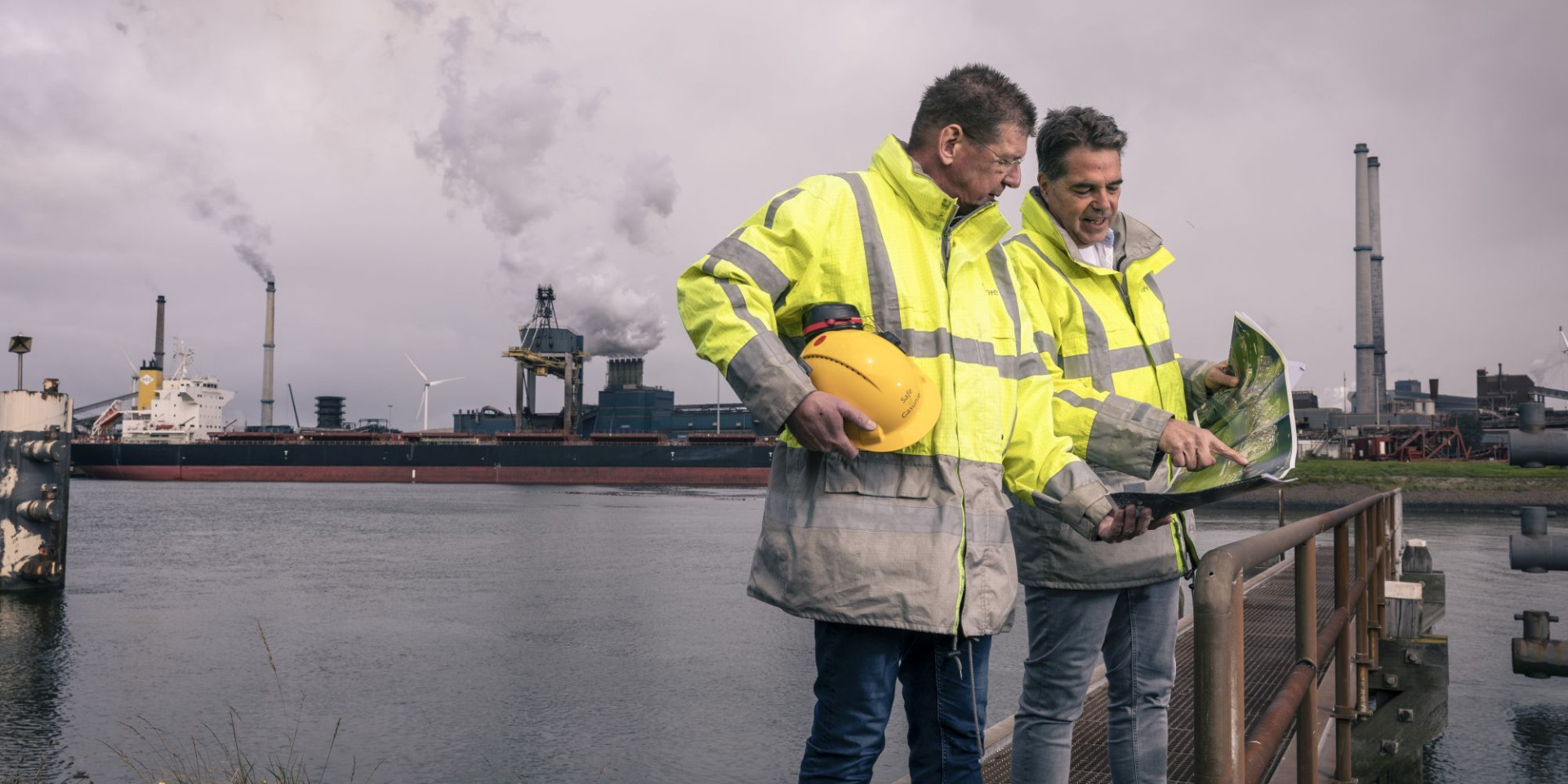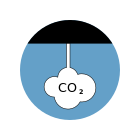
2.1 Strategy
Gasunie pursues a three-pillar strategy resting on the foundations of our organisation.
Optimising infrastructure: We facilitate our customers as much as possible with our infrastructure. We keep our costs down while retaining our social licence to operate.
Connecting Europe: We strengthen our position in our core area (Netherlands and Germany) through partnerships and greenfield projects. We advise on how to maintain security of supply and a liquid gas market.
Accelerating the energy transition: We lead the way in hydrogen and green gas and we play an active role in developing CO2 and heat transmission infrastructure.
Foundations of our organisation: We create a workforce with the right proportions and skills. We create a work environment and working conditions geared towards increasing focus, performance, a sense of purpose and job satisfaction. We continuously improve our governance, processes and collaboration.
Energy transition
Over the past few years, accelerating the energy transition has become an important, if not the most important, driver for Gasunie’s strategy and the reason why we have decided to transform our company from a gas transmission company into an energy infrastructure company.
In the 2020s, we have invested and will continue to invest in sustainable energy infrastructure on a major scale. We will reap the benefits of these investments in the 2030s and 2040s, as it will be easier on the demand side for society to switch to renewable energy and on the supply side to interlink different networks for electrons and molecules into one single jointly operating whole in what we refer to as ‘system integration’.
This is because we believe in a sustainable future with a balanced energy mix and a lasting role for diversified molecules. We believe that we serve our customers best with innovative energy infrastructure solutions.
2.2 Policy
In 2020, Gasunie captured its strategy in an outlook for the coming ten years: Vision 2030. Over this current decade, we will transform from a gas transmission company into a broad energy infrastructure company by 20301, we will be a company that transports, stores and treats natural gas, green gas, hydrogen, CO2 and heat in a safe, reliable, affordable and sustainable way.
We will play a key role in achieving the ambitious climate goals set in the Netherlands, Germany and the European Union. Every financial year, we update the investment agenda linked to Vision 2030 in our annual report. Gasunie has a Vision 2030 for each form of energy, as outlined in the ‘Action plans & Resources’ section.
Our strategy, and with that our energy transition strategy, has been prepared by our board of directors and greenlit by our Supervisory Board, having heard our sole shareholder, the Dutch Ministry of Finance. Regulatory authorities in the Netherlands and Germany are kept informed of our energy transition strategy through investment plans.
By cutting carbon emissions, Gasunie is contributing towards the United Nations’ Sustainable Development Goals (SDGs). Our efforts primarily go towards SDG 13 (climate action) and SDG 9 (industry, innovation and infrastructure). In addition, we also contribute to SDG 7 (affordable and clean energy) and SDG 17 (partnerships for the goals).
SDG 13: Take urgent action to combat climate change and its impacts
SDG 9: Build resilient infrastructure, promote sustainable industrialization and foster innovation
SDG 7: Ensure access to affordable, reliable, sustainable and modern energy
SDG 17: Revitalize the global partnership for sustainable development
1 Gasunie is currently working on a review of the business strategy and on the follow-up to Vision 2030: Vision 2040. In both the revised strategy and Vision 2040, climate efforts will feature more prominently than in the current strategy and Vision 2030.
2.3 Action plans
2.4 Resources
According to our current estimates, the value of Gasunie’s total net2 investment agenda from 2024 through to 2030 will come in at around € 11.5 billion. Of this amount, around € 7.9 billion is expected to be spent on energy transition projects.
We expect the vast majority of these projects to, either immediately or gradually, be made subject to regulation, meaning that we will market these assets at regulated tariffs.
For each project we look at tailor-made solutions that will keep the development and operating risks under control. There is a decision-making process for each project. Investment decisions are made by the Executive Board.
2 We want to carry out a number of projects with partners. The graphic shows only Gasunie’s share of the expenditures. The amounts shown are net of subsidies.
2.5 Risks and opportunities
Based on the double materiality assessment
Based on the double materiality assessment, enabling the users of our networks to reduce their carbon emissions leads to the following risks and opportunities for us:
Inside-out impact/risk (Impact materiality)
Outside-in impact/risk
(Financial materiality)
Based on our strategy
Based on our strategy, enabling the users of our networks to reduce their carbon emissions leads to the following risks and opportunities for us:
Geopolitics
Energy system
Internal
Based on the II3050 scenarios
Energy grids connect energy supply with energy demand. The transmission of green energy requires major investments for installing new grids and adapting existing grids. Since we do not know what the world will look like, we consider four cornerstone scenarios within which the carbon-neutral society is likely to take shape in 2050. The Integrated Infrastructure Survey 2030-2050 (II3050) sets out these scenarios in detail.
As a result of the close collaboration between Gasunie, TenneT, regional grid operators and other stakeholders in drawing up this vision, II3050 is a broadly supported outlook and guidance for government bodies, market parties and grid operators. It is Gasunie’s social duty to be able to serve society with our infrastructure in all circumstances.
The four future scenarios from II3050
The key conclusions from the II3050 report for Gasunie are:
- Hydrogen, green gas, heat and CCUS will be key elements in bringing about a zero-carbon future;
- Over the 2030-2040 period, we will need to more or less double the hydrogen transmission network planned to be completed by 2030, an expansion that can largely be facilitated by our existing gas infrastructure;
- The storage of hydrogen is essential if we are to keep the supply and demand for energy in balance in the future. This can be done in abandoned salt caverns in the Netherlands and Germany;
- Research is needed to determine the extent to which we can store hydrogen in depleted gas fields. Such storage facilities can play a key role as a strategic buffer during periods of insufficient solar and wind energy generation and as a backup if we lose a portion of the imports;
- The CCS network is not only a short-term solution: it will serve us in the long-term too. In the short term, we will transport captured CO2 to offshore storage fields to reduce industrial carbon emissions. In the long term, we will transport sustainable CO2 to industry for production processes that are currently still based on fossil resources (like oil).
The main understanding we draw from II3050 is that regardless of how the energy transition plays out, Gasunie has an important role to play. However, the opportunities and risks for our company differ per scenario. We have illustrated this in the visual below.
Risks and opportunities for Gasunie in the II3050 energy transition scenarios
2.6 Measurable goals
Gasunie is building a broad portfolio of heat grid, hydrogen and CCUS projects. The first investment decisions have now been made, driven by a broader definition of value creation and not only by maximising financial returns. The energy transition projects Gasunie is developing will enable Gasunie grid users to cut many megatonnes of emissions in the coming years.
* We published a similar table in the 2022 annual report. Our expectations at that time were as follows:
- for hydrogen: (2025: 0.9) (2026: 2.5) (2027: 3.0) (2028: 3.5) (2029: 5.2) (2030: 6.7);
- for CCS: (2025: 1.3); (2026: 2.5); (2027: 5.6); (2028: 8.8); (2029: 12.5); (2030: 12.5).
Our investment plans for the German national hydrogen transmission network Hyperlink can also deliver several megatonnes of carbon cuts and contribute to Germany moving further along its transition pathway.
The Netherlands aims to be climate neutral by 2050. To get there, as a country the Netherlands must cut its average carbon emissions every year over the coming decades: it needs to the what’s called the National Transition Pathway (see the yellow line in the bar charts below). However, as can be seen in the Climate and Energy Outlook (C&EO) report published by PBL Netherlands Environmental Assessment Agency, the Netherlands is lagging behind on this pathway (see the dotted line in the bar charts below).
If Gasunie were to be facilitated in implementing its current investment programme in the coming years completely and without delay, we in turn would be able to facilitate the Netherlands in closing a significant part of the gap between the Climate and Energy Outlook and the Transition Pathway. We think that, through our energy transition projects, grid users can cut 25.6 Mt of carbon emissions by 2030. To illustrate: the Netherlands’ total carbon emissions in 2022 were 158.4 Mt.3
3 Statistics Netherlands (CBS), Emissions of greenhouse gases according to IPCC guidelines
Investments ensure that the Netherlands does not lose sight of the Transition Pathway (figures in Mt/year)
The chart above shows the avoided emissions in the Netherlands facilitated by Gasunie; for 2030 these are expected to be 25.6 megatonnes (Mt). Gasunie’s transition investments mainly ensure carbon reductions in the industry and built environment sectors. If other sectors in the economy play their part, the rest of the gap can be closed, too, and we will stay on track to become carbon neutral in the Netherlands by 2050.4
The effect of our investments up to the end of 2030 is also apparent if we extend the horizon to 2050, as shown in the illustration below. Users of the Gasunie infrastructure will then emit less CO2 (see the yellow area) and can even achieve net-zero emissions sooner than the national target date.
4 See the appendix to this document for an explanation of our calculations.
Gasunie infrastructure users can reach climate neutrality sooner than the target date (figures in Mt/year)
Gasunie will still have a big job ahead of it after 2030. The hydrogen system in particular will need to be expanded, and we also foresee further growth in green gas and follow-up investments in CO2 transmission. For an explanation of our contribution to the National Transition Pathway, see the appendix to this Climate Action Plan.
We are, for now, only considering the effects of our investments between 2020 and 2030. A new series of Gasunie investments for the period from 2030 to 2040 could lead to a steeper decline along the Dutch transition pathway.
2.7 Achievement of our goals
In 2023, our sustainable energy grids helped grid users reduce their emissions by 0.1 megatonnes. This is in line with the ambition we had set ourselves for that year.
In late 2023, we made the final investment decision for the first projects from the Vision 2030 portfolio. While we are seeing some slowing of the development of our hydrogen portfolio through to 2030, our CCS portfolio has grown. Gasunie is not allowed to get involved in the production of gases (renewable or otherwise), but we are working to increase the share of renewable gases in our network by enabling the transmission and storage of such energy carriers.
We recalculate this contribution to the National Transition Pathway every year, taking the latest knowledge and insights from within the company and from external parties into account. Compared to the 2022 reporting year, we anticipated later-than-expected commissioning of the Porthos project but higher reduction levels in the 2023 reporting year, as well as lower-than-expected utilisation of the national hydrogen transmission network. We were also able to draw on new emission forecasts from the 2023 Climate & Energy Outlook.
The Vision 2030 investment portfolio is adapted on a regular basis to market demand and permitting process lead times. At the time of writing this plan, we went by the following forecasts for the pending final investment decisions and the completion timelines:
| Type | Project | Year of FID* | Year of completion* |
|---|---|---|---|
| Heat | WarmtelinQ Vlaardingen-Den Haag | 2021 | 2025 |
| CO2 | Porthos | 2023 | 2026 |
| Hydrogen | Waterstofnetwerk Rotterdam | 2023 | 2025 |
| Heat | WarmtelinQ Rijswijk-Leiden | 2023 | 2027 |
| Heat | WarmtelinQ Vondelingenplaat-Vlaardingen | 2024 | 2026 |
| Hydrogen | Hyperlink -1 | 2024-2025 | 2027 |
| Hydrogen | Hyperlink-4 | 2024-2025 | 2027 |
| CO2 | Aramis | 2025-2026 | 2028 |
| CO2 | CO2next | 2025-2026 | 2028 |
| Hydrogen | Hyperlink-3 | 2024-2025 | 2028 |
| Hydrogen | Hyperlink-5 | 2024-2025 | 2028 |
| Hydrogen | Hyperlink-2 | 2024-2025 | 2029 |
| Hydrogen | Hyperlink-6 | 2024-2025 | 2030 |
| Hydrogen | Hynetwork** | 2024-2027 | 2030 |
| Hydrogen | Hystock 1e caverne | 2025-2026 | 2030 |
| Hydrogen | Hyone | 2025-2026 | 2031-2032 |
2.8 Financial impact
Given that Gasunie sells natural gas transmission and storage capacity to third parties, Gasunie’s cash flow is relatively predictable. How much revenue we are allowed to generate from this core business is determined annually by the regulatory authorities in the Netherlands and Germany, i.e. ACM and BNetzA respectively. In determining this, they consider the infrastructure management and maintenance costs incurred by Gasunie today and over the coming decades.
Under Vision 2030, Gasunie aims to invest a total of € 11.5 billion, with € 3.6 billion for maintenance and replacement and € 7.9 for new CO2, hydrogen, heat and green gas transmission and storage infrastructure projects. We expect that at least the new business units that will operate in the hydrogen and heat domain to also come under the supervision of the regulatory authorities.
We intend to use borrowed capital to fund a substantial part of our energy transition investments, preferably borrowed capital in the form of green bonds, i.e. bonds where the proceeds are invested in energy transition projects in full. Another part of the investments will be financed from our own cash flow and through grants from the Dutch state. On the back of these investments, our balance sheet total will nearly double to around € 20 billion by 2030.








